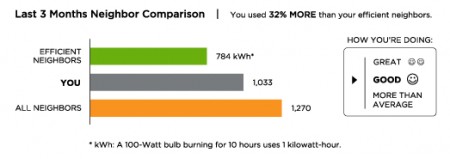I’m excited to announce the results of a new EDF study that analyzes the potential to reduce energy use and our environmental impact using one of the cheapest inputs in the world: information. At EDF, we’ve always believed that the right set of consumer-facing energy efficiency tools and technology could allow families to take charge of their energy usage, cut down on their monthly bills, and shrink their carbon footprint – and now we have proof.

We collaborated with an innovative start-up called Opower to look at the potential for simple graphs and data to drive energy savings. We analyzed 22 million electricity bills, spread across 11 utilities, to see how households react to energy-savings tips and – most importantly, and originally – a graphic that shows them how their usage stacks up against their neighbors’.
Our findings, in a nutshell: information pays. The 771,000 households who received Home Energy Reports (Reports) reduced their electricity usage by 1.8% on average. While we can only speculate about what would happen in other settings, that number jumped out at us, and for good reason. If every home in America reduced their electricity usage by that much, we would all see the following benefits:
- $3 billion in savings on energy bills;
- 26,000 gigawatt-hours of reduced electricity-demand – enough to power the homes of 5.6 million Americans; and
- 8.9 million metric tons of reduced carbon emissions, which is equivalent to the annual emissions from three 500 MW coal-fired power plants.
We also looked at how different types of households respond to the Reports and found some interesting results. For instance, in most of the utilities we looked at, the “energy hogs” are the most likely to roll back their energy usage. If you were to use that fact to target reports at “high-potential” households, you could boost the average reduction to 6.8% – more than three times the sample-wide average.
Energy efficiency is widely considered one of the greatest untapped energy resources. This study confirms that simple behavioral changes generate consistent savings across a wide range of utilities and demographics. The message is clear: customers empowered with information on energy usage are more likely to save energy and money, all while reducing their carbon footprint.
We hope that simple, innovative tools like this one will spread far and wide.
[Editor’s Note: This latest column from Environmental Defense Fund is a cross post from the organization’s Energy Exchange blog. It is penned by Matt Davis, EDF Research Fellow and author of the study.]